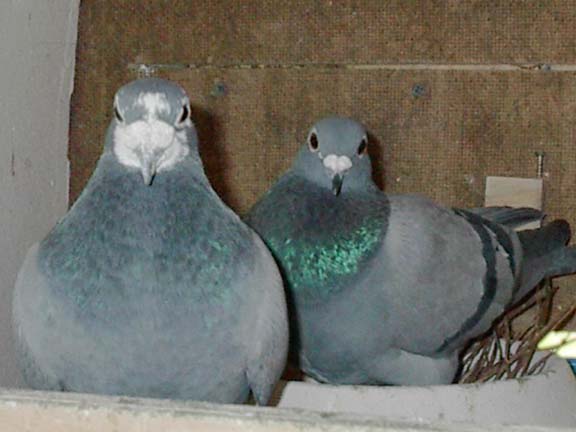 Preperations for the race actually start long before the racing season even begins. Early in the year, typically somewhere
between the middle of Feb to the beginning of march, Birds are paired up. There is usually a lot of thought put into these
pairings, coming up with the right combination can be very rewarding. Approximately 10 days after birds pair up the first
of two eggs is layed, usually in the late afternoon early evening the second egg is layed two days later early afternoon,
during this period the pair will set the single egg but not very seriously. Only after the second egg will the pair get serious
about incubation. This ensures that both young hatch at the same time. If they hatched a day or two apart the second youngster
would be smaller and eventually die because it will not be able to compete for food. Incubation takes 18 days, during which
both parents take turns setting the eggs. Generally the Cocks set the nest during the day the hens during the night. After
18 days the new chicks should arrive. Congratulations, if all goes well here your first two race team members have arrived.
Around day 8 to 10 the youngster is banded. This is a seamless leg band with a unique identification number along with the
year and initials for the club or orginization represented. An example would be AU/SCO 2002 10101. This band is slipped over
the youngsters foot which is at just the right age that the band barely fits over the foot. After a couple days the band is
permenant., the bird will carry this ID the rest of its life
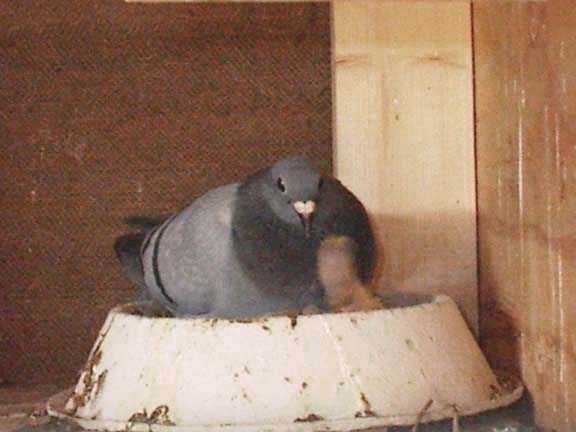
|
| Feed me Mama |
AU----------American Racing Union
SCO---------Spartenburg County Open Club
2002--------Year the bird was raised.
10148-------Unique identification number.
When the youngsters are about 28 days old they are ready to move to the Flying loft for settling. It is important at this
point to watch the birds at feeding time to make sure they are eating on their own, they will look as if they don't know what
they are doing but if they are pecking at the seed and making any kind of attempt, they will probably be all right. Also you
have to make sure the birds know where to find their water. This is very important as a couple days could mean the end. If
you notice a bird not getting to the water, usually dunking the beak in the water a couple times will get them accustomed
to the location and they should be fine.
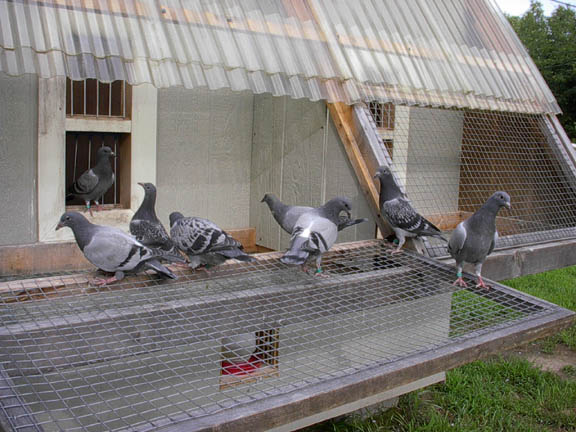
|
| 2003 Young birds tasting freedom |
Once the Youngsters are eating and drinking it is time to get them accustomed to the outside world. This usually starts by
placing the birds on the landing board. There are many ways to go about this. My preferred method is to install a wire enclosure
around the landing board and a trap entering the loft from the board. This allows the youngsters to get accustomed to trapping
and the view of the outside. After a few days the birds will start coming in and out of the trap, this is when the wire enclosure
is removed and the birds are allowed total freedom. Start by letting the birds sit on the landing board for a few minutes
then call them in. After a while you will see the birds starting to flap their wings and hovering a few inches above the landing
board, gradually getting further and further from it. One day they will take off for a lap around the yard and back to the
board. Then a bigger lap, a bigger lap then off for a five or ten minute flight. There are several different ways to exorcise
young birds. Some people like to give their birds total open loft, meaning: they will open up the loft in the morning and
close it up in the evening, leaving the birds to come and go as they please. Others will let there birds out to fly and leave
them out for 1 or more hours. Some let their birds fly in the morning and others in the evening. I prefer to keep my birds
on a tight leash. I train my birds to a whistle and thereby control there free time. Due to my work I fly my birds in the
evening and I let them stay out as long as they are flying. Once they come down they are called in. I do this for a couple
reasons. 1. I do not like to let my birds loiter around outside the loft for fear of attracting hawks. 2. I feel that by calling
my birds in as soon as they quit flying, they will not hesitate going in when returning from a race. After a while the birds
will start disappearing for a while flying further and further away. This is referred to as routing. Once the birds start
routing its time to start conditioning for the racing.The birds are crated up and taken a couple miles from home and released.
This is primarily to get the birds used to the crate. After a couple trips the distance is increased. A couple more releases
and another increase. This is done throughout the summer up until race season. I like to have my birds flying from 50 to 100
miles before racing starts.
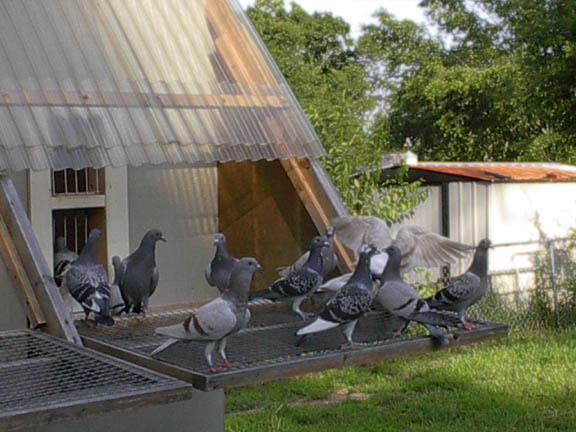
|
| 2003 Round one young birds in training |
Racing Season usually begins around the middle of September, this is considered the Young Bird races.
Only birds hatched in the current calendar year are eligible to fly these races. Birds hatched in prior years fly in the Old
Bird races which start around April. A typical Young Bird race season will have two 100 mile races, two 150 mile races, two
200 mile races a 250 mile race and a 300 mile race, Old Birds will have a 400, a 500 and sometimes a 600 mile race added.
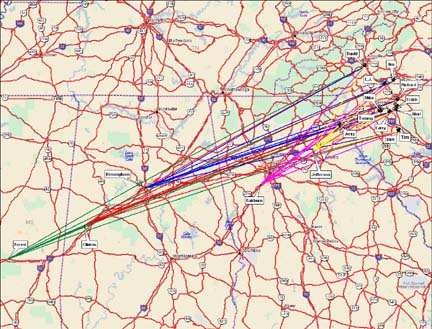
Birds are selected for the race based on health and fitness of the bird, you can normally tell by
handling a pigeon if they are ready to go to the race. Selected birds are taken to the clubhouse for band up. At this point
a rubber counter mark (a rubber leg band with a set of numbers imprinted on it) is placed on the birds leg and recorded along
with its unique ID band number, and then placed into a crate to mingle with the competitors birds. Once all birds are countermarked
they are ready to start their trip to the release point. The crates are loaded onto a special trailer and the journey begins.
Along the route there are some stops where more birds are collected. Some races will contain upwards of 15,000 pigeons.
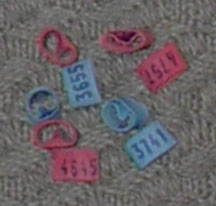
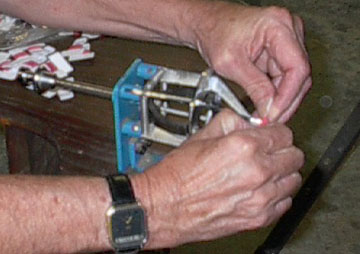
The birds are taken to a specific location, weather is checked along the race course and if everything
is a go, they are released to start the trip back home where the owner anxiously waits. Surveys have been done and the distance
from the release point to the loft down to the yards is known. When the doors to the crates drop open, these amazing little
creatures burst out with the energy and a drive to get back home that we can only try to imagine. They have one thing on their
minds and that is to get back to their mate or perch. They can average 50 to 60 MPH on the way home and cover distances of
600 miles in a single day. When they arrive home the rubber marking band is removed from the leg and inserted into a sealed
clock where the time and date is stamped to record the arrival. After the race closes, the clocks are opened and the tapes
read and compared to the marking bands and permanent bands. The distance flown in airline miles is divided by the time of
flight and a figure of yards flown per minute is attained. The fastest bird is the winner. The winners get to gloat for a
week and the rest get to figure out what they can do to get their birds home quicker.
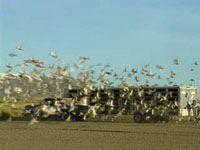
I have been flying for about 6 years now, and I can think of no greater feeling than to see those
birds break over the horizon and hit the loft. Holding a bird in my hand and trying to convince myself that just a few hour
earlier, it was released hundreds of miles away and now it is back here with me, amazing, simply amazing.
Looking
for a new hobby? Something that is relatively inexspensive? Can be enjoyed by the whole family? Give racing pigeons some consideration.
You wont be disappointed.
Video of a race release
|

